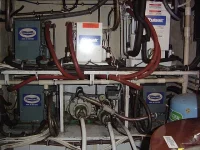eze2bme
Well-known member
- Joined
- Apr 12, 2005
- Messages
- 880
- Hatteras Model
- 43' DOUBLE CABIN (1970 - 1984)
I have just returned from the Hatteras Owner's School this week and one topic of discussion concerning the AC system pertained to cleaning the water circulation side of the system on a regular basis (every two years) to remove calcium and other deposits. I wanted to express their thoughts for all to consider and get any feedback.
I hope I got all this correct: Even though you may be getting what you perceive to be good water flow as evidenced by the water exiting the system overboard, there may be deposits inside the plumbing that can cause lower water flow than what is desirable which can lead to the pump overheating, higher electrical usage and possibly eventually causing the pump to fail. They recommended running a cleaning solution through the system in a closed loop for at least 30 minutes. This can be accomplished using a five gallon bucket with a suction hose hooked to the pump and a discharge hose hooked to the discharge side of your system. MAKE SURE TO CLOSE THE SEA COCK FIRST! Turn on the system to the pump or fan setting (not heating or cooling) and let it run for 30 minutes. Your cleaning water solution will get increasingly dirty. Afterwards the system needs to be flushed with vinegar water to neutralize it.
This is important in salt water and fresh water.
If I have any of this wrong please make corrections!!!
I hope I got all this correct: Even though you may be getting what you perceive to be good water flow as evidenced by the water exiting the system overboard, there may be deposits inside the plumbing that can cause lower water flow than what is desirable which can lead to the pump overheating, higher electrical usage and possibly eventually causing the pump to fail. They recommended running a cleaning solution through the system in a closed loop for at least 30 minutes. This can be accomplished using a five gallon bucket with a suction hose hooked to the pump and a discharge hose hooked to the discharge side of your system. MAKE SURE TO CLOSE THE SEA COCK FIRST! Turn on the system to the pump or fan setting (not heating or cooling) and let it run for 30 minutes. Your cleaning water solution will get increasingly dirty. Afterwards the system needs to be flushed with vinegar water to neutralize it.
This is important in salt water and fresh water.
If I have any of this wrong please make corrections!!!


